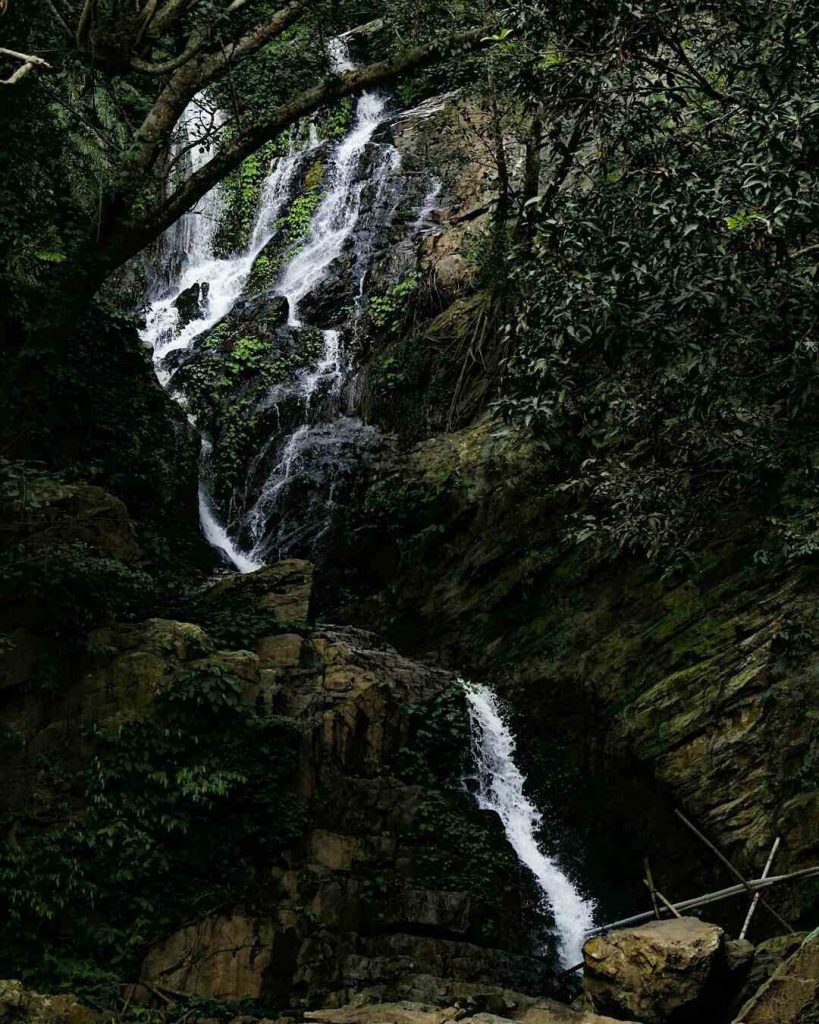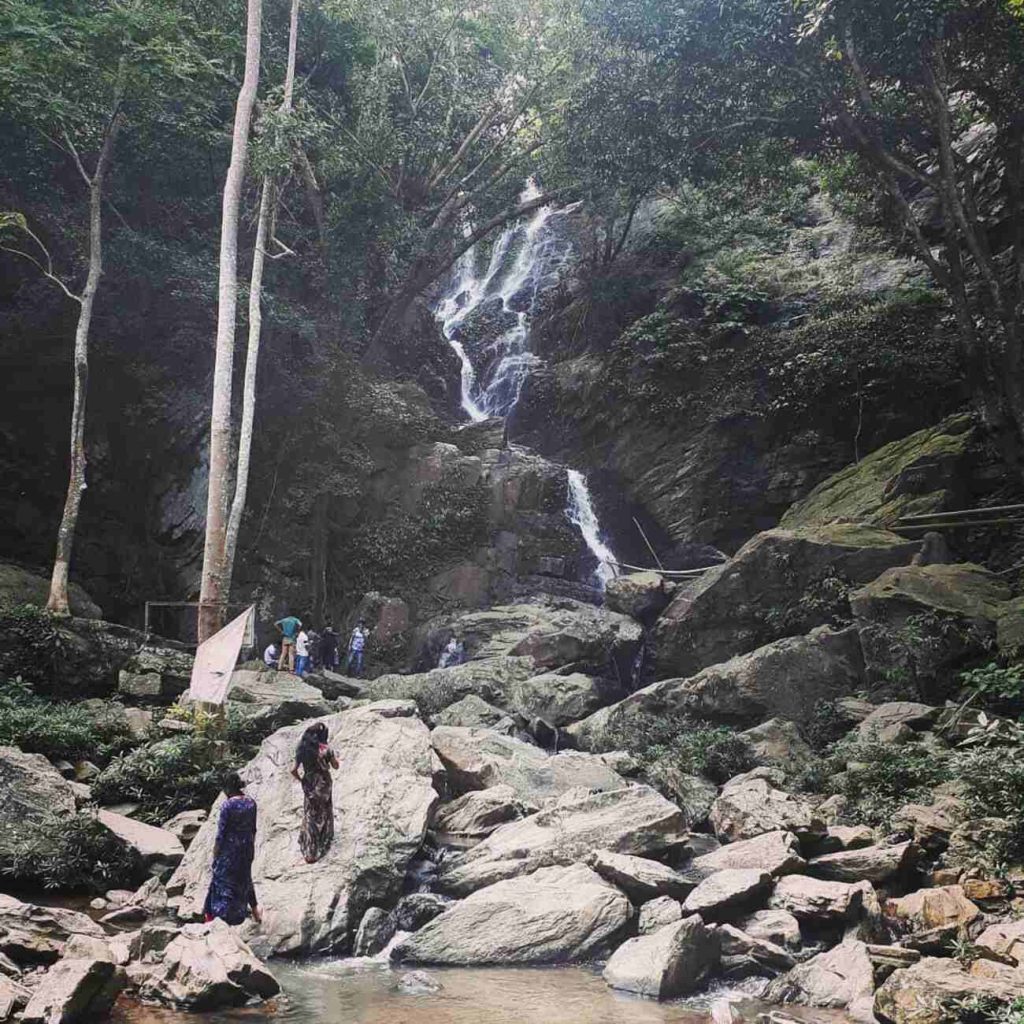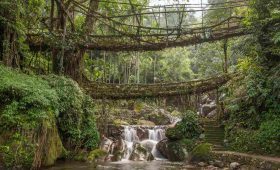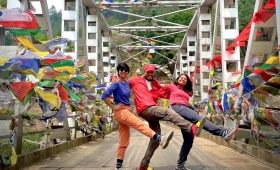Imagine standing at the precipice of nature’s grandeur, where the world falls away in a thunderous cascade of crystal-clear water. Nestled in the heart of Assam, India, the Akashiganga Waterfall is a masterpiece sculpted by time, a testament to the raw power and ethereal beauty of nature. Often hailed as the biggest waterfall in Assam, this natural marvel is more than just a visual spectacle; it’s a sacred pilgrimage site steeped in Hindu mythology and an adventure seeker’s paradise.
As you approach the waterfall, the air thickens with the intoxicating blend of damp earth, fresh greenery, and the distant roar that promises an unforgettable encounter. The journey itself is a reward, as you traverse through lush rainforests, crossing meandering streams, and encountering diverse flora and fauna.
Akashiganga Waterfall: A Pilgrimage of Purification
Wrapped in ancient legend, the Akashiganga Waterfall is a holy place connected to the tragic story of Sati and Shiva. Hindu mythology tells of Sati, Daksha Prajapati’s daughter, who died tragically out of deep shame. Overwhelmed by grief and anger, Shiva carried her lifeless body through the heavens. To bring peace, Lord Vishnu divided Sati’s body into 108 sacred pieces spread across India.

It’s said that one of these divine parts fell here, making it a place of deep spiritual importance. People believe the waterfall’s water is pure and holy, able to cleanse sins and bring salvation to those who bathe in it. The Akashiganga Waterfall becomes especially crowded during Makar Sankranti, or Magh Bihu, a major festival in Assam. This harvest festival celebrates the sun entering Capricorn, a time of new beginnings. People from everywhere come to the waterfall, filled with faith and hope. The air is full of prayer songs as pilgrims bathe in the cold water, looking for blessings and purity.
Trekking Experience to Akashiganga Waterfalls
Take an exciting hike through Assam’s green rainforest to find the amazing Akashiganga Waterfall. The trip is as fun as the final view. Walk through a maze of tall trees with leaves that make sunspots on the ground. Listen to birds singing, leaves rustling, and the waterfall’s faraway sound – it’s like magical music. As you climb higher, the air feels fresh and good, smelling like wet earth and special plants. With every step, you get more excited to see the amazing view. Finally, the path opens up to show you a beautiful picture – the Akashiganga Waterfall falls down the rocky cliff, like a foamy, shiny silver curtain in the sunlight. The water is powerful and makes you feel small.
Beyond the Biggest Waterfall in Assam: A World of Discoveries
The Akashiganga Waterfall is more than just a stunning sight. It’s a holy place linked to the goddess Sati. The nearby Akashiganga Temple is peaceful and full of beautiful, old carvings. Spending time there helps you feel calm and connected to something bigger.
History buffs will love exploring the nearby Doboka ruins. These old buildings show how amazing this place used to be. Imagine walking through the remains of an ancient city and trying to figure out how people lived.

After all the excitement, relax by Akashiganga Lake. Rent a boat, pack a picnic, and enjoy the peace. Birdwatchers will love seeing all the different birds.
For adventure lovers, there are lots of hikes to choose from. Walk through the rainforest, find hidden waterfalls, and see amazing wildlife like elephants and bison.
Planning Your Trip to Akashiganga Waterfall
Get ready for an unforgettable adventure at Akashiganga Waterfall! Here’s everything you need to know:
Best Time to Visit Akashiganga Waterfall
The best time to visit Akashiganga Waterfall is from October to March because of pleasant weather. If you love adventure, visit during the monsoon for a thrilling experience, but be prepared for rain.
How to reach Akashiganga Waterfall
Akashiganga Waterfall is about 11.6 kilometers from Doboka Town, Assam. You can easily reach it by bus, taxi, or car. The nearest airport is Guwahati.
What to Pack:
- Comfortable, breathable clothes
- Sturdy shoes for hiking
- Swimsuit for a refreshing dip
- Essentials: sunscreen, insect repellent, hat, sunglasses, camera, and a first-aid kit
Where to Stay: Doboka Town has various hotels and guesthouses. Book in advance, especially during peak season.
Respect Nature: Protect this beautiful place. Don’t litter, avoid disturbing wildlife, and follow local rules.
By following these tips, you’ll have a wonderful time exploring the Akashiganga Waterfall.
Don’t let this extraordinary experience slip away. Plan your journey today and immerse yourself in the enchantment of the Akashiganga Waterfall. Share your adventures, tag us on social media, and let the world know about this hidden paradise.
FAQs
-
Where is it located?
Akashiganga Waterfall is located near Doboka Town in Hojai District. Easily accessible via National Highway 36, it’s approximately 11.6 kilometers from Doboka.
-
What kind of wildlife can be spotted around Akashiganga Waterfall
The Chirang Reserve Forest, home to Akashiganga Waterfall, teems with life. From the colorful symphony of birds and butterflies to the occasional sighting of majestic elephants, the area offers incredible wildlife encounters.
-
Are there any nearby attractions?
The Akashiganga Waterfall area offers more than just stunning cascades. Nearby attractions include the wildlife-rich Manas National Park, a UNESCO World Heritage Site, the historic Barpeta Satra monastery, and Orang National Park, famous for its one-horned rhinoceros population.
-
What are the best times of the year to visit Akashiganga Waterfall
For the best possible experience, plan your visit to the waterfall between October and March. Not only is the weather more agreeable and the water flow stronger, but you’ll also encounter smaller crowds. The month of January is particularly special due to the Magh Bihu festival.



